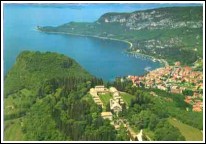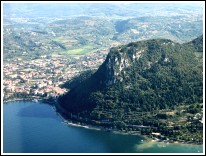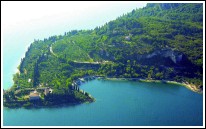| |
|
Outline of Garda

Gardas origins are very ancient and numerous findings of prehistoric time testimony this. In the late 1800s at the feet of the Rocca di Garda, lake dwellers remains were found, together with ceramics and bronze items, dating back to a recent-medium bronze age. During the sixties, in the locality of Sabbionara near Marciaga, ceramic fragments of early bronze age were found and in Via San Bernardo nineteen tombs with vases, bowls, bronzes and fashioned bones of the late bronze age were found.
The testimony of greatest interest is the rock carvings on Mount Luppia. Figures traced by man on the rocks of warriors, weapons, soldiers, labyrinths, animals and crosses which cover four thousand years of history. Also significant is testimony of Roman times. The shape of the historical centre, with its main street that runs straight from one door, entrance to the town to the other on the other side of the town, its tiny streets which come together perpendicularly, the memorial stone which is found in Roma Square, various tomb stones are all testimony of the existence of an ancient Roman village.
On the Rocca, during medieval times stood the castle of Garda, so important that the lakes name changed from the latin Benacus to the present Lake Garda.
The name of this town, of 3,700 inhabitants derives from the Germanic word warda guard, look-out which was the function of the Rocca, erected on the rocky spur, overlooking Garda. Of Roman age, it was destroyed and reconstructed many times, now there are only a few ruins remaining. There is a lot of evidence of the presence of man in ancient times. Various signs of the Roman period such as: memorial stones, inscriptions, tomb stones, coins and tombs.
With the Barbaric invasion Garda became property of the Goths, the Longobards, and the Franks. Slowly, during the eleventh century the name of Garda extended along the territory, including the area around the lake, which from that moment changed the latin name of Benaco into Lake Garda. After that the Scaligeri from Verona, and the Visconti from Milan came and from 1405 Venice with the Capitano del Lago, which represented the Serenissima.
Today Garda, in the centre of the gulf, has become an equipped holiday locality with numerous residences and a modern congress hall. Well known by the neighbouring Germans and Austrians it has now become a popular holiday location for European tourists and tourists world wide. Garda is also close to the beautiful artistic city of Verona, which with its magic atmosphere.
Garda Historical visits

The build-up area conserves its ancient characteristics: narrow lanes with small buildings, of great charm, often linked by large barrel shape arches, but even ancient houses with beautiful fronts which are typically of Venetian design. In the city of Garda you must definitely see the Palazzo dei Capitani, which dates back to the XV century, it was the ancient residence of the Capitano del Lago, once it was right on the lakes banks and is an excellent example of Gothic-Venetian architecture.
On the lake front you can also see the Ancient Dogana, known as Losa (the ancient customs) which was projected by the architect Sammicheli. Also to see in the city is the 1500s Palazzo Fregoso, owned by the Genovese military leader Cesare Fregoso, official of the Venetian Republic and protector of the writer Matteo Maria Bandello who loved living here and maintained possession, at least until the arrival of Napoleon.
Well worth is a visit to Palazzo Carlotti, recently renovated. Famous for its meetings, of which even Gabriele DAnnunzio took part. Also Villa Becelli-Albertini, dating back to the 1500s, which conserves its little castle like settting and its magnificent internal garden deserves a visit. Worth a mention are also Villa Canossa and the Palaces Pompei and Merlo.
In the ancient part of the city a visit to the Chiesa Maggiore of Santa Maria Novella is a must. Patron of the city, it was built on the foundations of the ancient church. It has three central naves, each of which with an alter (the ones on the left are in Baroque style). It also conserves a nice 13th century bell tower and cloister of the same period. The baptistery was built later, about mid 15th century. To see is also the church of Santo Stefano, XV century, the Clock Tower, which together with Palazzo Fregoso mark the two doors of access to the historical centre.
Nearby you can admire beautiful landscapes, like the famous Punta San Vigilio, a promontory of fascinating charm, which has inspired poets and artists of different eras and of which today is a place of major attraction for tourists from all over the world. Here, in the surrounding lush vegetation, the Veronese, humanist Agostino Brenzoni had Villa Guerienti built, which was projected by the architect Sammichelli. It is a charming building , which blends well with the surroundings. Characterized by its simple, linear form, which recalls the traditional architecture of the Veneto region for that period.
Next to the villa there is the small church of San Vigilio, in a romantic position on the cliff overlooking the lake. On the Scoglio della Stella you can feel the magic in the air. A legend tells that a nymph was transformed into rock (Scoglio della Stella) in virtue of an ancient spell.
Landscape and what to see

The gulf of Garda is a jewel, dominated by the blue waters of the lake and the Mediterranean vegetation, closed at the north by Mount Luppia, which falls into the lake forming the enchanting Punta San Vigilio, a stop which is a must for many celebrities on holiday on the Riviera. It can be explored by following a marked path starting just before San Vigilio, near the Belvedere. This area is very well known for the incisions on the rocks, some of which date back to the Bronze Age. Stopping at Loc. Castei you can enjoy the view of a large part of the lake, and also of the renowned Baia delle Sirene (Mermaids Bay), a beach, next to San Vigilio which is immersed in a centuries old olive grove.
Instead south there is the Rocca Hill. The hill can be reached by two roads. The first, going up to Loc. San Bernardo starting from the parish church and reaching Loc. Canevini. Here the walk runs along the side of the canevini, natural cellars dug out of the rocks, where the inside temperature remains constant in summer and also in winter. Going ahead we arrive at the Madonna del Pign and following the marked path arriving at what we all call Il cavallo della Rocca (The Roccas horse), this is the point where all the paths meet bringing to the tre Rocche. Following Rocca Maggiore or Rocca di Garda, soon after, you will arrive at the hills summit where you can enjoy a breath taking view.
On the east side you can find the town of Costermano, where a visit to the Valley of the Mills is a must. Crossed by a stream, a marked path joins the two towns of Garda and Costermano, and the villages of Castion and Marciaga, where you can find an excellent rock climbing, open air gym and a very well equipped equestrian centre. Very romantic are the water mills, in the olden days they were used for grinding wheat. Along the valley you can also find the Health Trail, which can also be run by mountain bike, following numerous marked tracks of our inland area.
|
|
|



